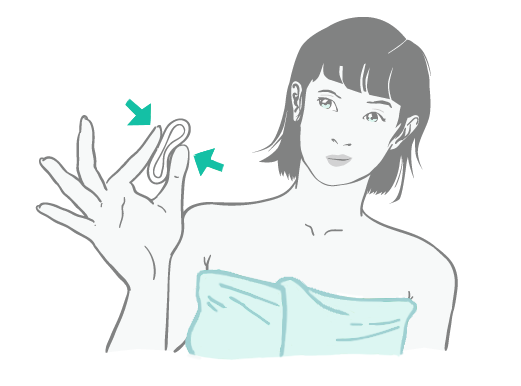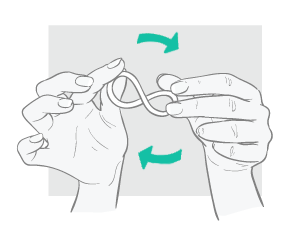- Birth control
- Birth control ring
- Monthly birth control ring (NuvaRing)
Monthly birth control ring (NuvaRing)

What is the monthly birth control ring (NuvaRing)?
The monthly birth control ring (NuvaRing and its generic versions) is a clear, bendable birth control ring that you insert into your vagina. You leave NuvaRing in place for three weeks at a time, then take it out for the fourth week. That’s usually when you get your period. At the end of the fourth week, you insert a new ring.
NuvaRing contains two different kinds of hormones, estrogen and progestin, that work together to prevent pregnancy. These hormones are absorbed through the vagina. The main way they prevent pregnancy is by stopping ovulation from happening, which means that the ovaries don’t release an egg. Generic versions of NuvaRing contain the same hormones and work in the same way.
Quick Facts
-
Effectiveness
The monthly ring (NuvaRing) is very effective the way most people use it.
Perfect use: Over 99% effective
Typical use: 93% effective
What are perfect use and typical use?
-
Hormones
The monthly ring contains two different kinds of hormones, estrogen and progestin.
-
Side effects
Most common—but usually temporary—side effects are irregular bleeding, headaches, sore breasts, and nausea.
-
Cost
Anywhere from $0 (with insurance) to $200 a month.
-
STI protection
The monthly ring doesn’t protect against STIs.
-
Ongoing effort
Ring in. Wait 3 weeks. Ring out. Wait 1 week. Repeat. Get a new ring each month.
The monthly birth control ring might be right for you if...
Effectiveness at preventing pregnancy is a top priority for you.
NuvaRing is over 99% effective at preventing pregnancy when used perfectly (exactly as directed). That means fewer than one out of every 100 people using NuvaRing perfectly for a year will get pregnant.
However, the effectiveness of NuvaRing with perfect use is based on the experiences of people involved in clinical trials who are using NuvaRing perfectly for an entire year. The effectiveness of NuvaRing with typical use, which means how real people use it in real life, is going to be more relevant for most people. In the case of NuvaRing, when it’s used as people typically use it, it is 93% effective at preventing pregnancy. That means that on average, seven out of every 100 people using NuvaRing for a year will get pregnant.
The combination pill, the monthly ring, and the patch are all equally effective.
You’re looking for a lower dose of hormones.
The ring uses a lower dose of hormones than other hormonal methods, so there may be fewer side effects. And because you aren’t taking the hormones by mouth, they don’t pass through your gastrointestinal system, so you can expect fewer side effects that affect that system, like nausea.
You want to put in relatively little effort each month.
If remembering to take a pill every day is not for you, the ring might be a good option. You only have to remember to take action twice a month: once to take the ring out and then once, a week later, to put a new ring in.
You want the option to skip periods.
If you’re using NuvaRing and want to skip periods, you can leave it in for up to five weeks instead of three. You can skip a single period this way or multiple periods throughout the year. You can even skip all of your periods for a year by inserting a new ring as soon as you take the old one out instead of spending a week without the ring in. Just remember to replace your NuvaRing with a new one at least every five weeks.
You’re comfortable touching your body.
Putting in NuvaRing involves putting your fingers inside your vagina. It’s a lot like putting in a menstrual cup or menstrual disc, so if you’re fine with doing those things, you should be good to go.
You aren’t looking for STI protection, or you’re okay with combining the ring with another method.
The ring doesn’t offer any STI protection. So if that’s something you’re looking for, you can use condoms or internal condoms along with the ring. Dental dams and/or gloves also offer STI protection, depending on what kind of sex you’re having. You may also want to consider PrEP (pre-exposure prophylaxis), which is a daily pill or an injection you can get every two months to decrease your risk of getting HIV.
You want a method that won’t permanently affect your fertility.
The only birth control method that permanently affects your future fertility is sterilization. NuvaRing does not affect your ability to get pregnant after you stop using it. In fact, you’ll return to whatever level of fertility is normal for you (which just means that you may be able to get pregnant) quickly after you go off the ring. So if you’re planning to stop using the ring, but you don’t want to get pregnant, protect yourself with another method right away.
You want a method that you can stop without help from a provider.
You can stop using NuvaRing without having to see a provider. Just keep in mind that you will quickly return to whatever level of fertility was normal for you before using NuvaRing, which means you may be able to get pregnant right away. If you don’t want to get pregnant, make sure to use another form of birth control as soon as you stop using NuvaRing.
You don’t need to hide your method.
NuvaRing is not one of the birth control methods that is easy to completely hide. If you’re storing NuvaRing (without opening it) for more than 4 months, it needs to be stored in the refrigerator. So if you share a refrigerator with people, and you don’t want them to know you’re using the ring, that could be a problem.
Also, some people with penises say they can feel the ring during penis-in-vagina sex. (Yes, it’s designed for you to leave in during sex!) So if you’re trying to hide that you’re using birth control from a sexual partner, the ring may not be the best choice.
You don’t have these risk factors.
For most people, the risk of blood clots while using the ring is very low. However, there are some things that greatly increase your risk, like:
- Previously having had a blood clot or having certain inherited conditions that increase your risk for a blood clot.
- Smoking cigarettes if you’re 35 years old or older.
- Having uncontrolled high blood pressure.
- Having heart disease or having had a heart attack or a stroke.
- Having recently had major surgery, if you won’t be able to get out of bed for a while.
- Having migraine with aura.
- Having had a baby less than three weeks ago.
- Having tested positive for antiphospholipid antibodies.
If you have any of these risk factors for blood clots or if you’ve had breast cancer or serious liver disease, it’s not recommended that you use either type of ring, the patch, or any of the combined hormonal birth control pills (the most commonly used kind of birth control pill). Check with your medical provider about other options.
How do you use the monthly birth control ring?
NuvaRing is pretty easy to use. All you really need to remember is the schedule for putting it in and taking it out.
Once you insert your NuvaRing, leave it in for three weeks (21 days). Take it out for the fourth week (that means that you’ll leave it out for seven days). When the ring is out, you’ll probably get a withdrawal bleed, which is like a period. After seven days, even if you’re still bleeding, insert a new ring and start the cycle again.
You will always take your ring out and put a new ring in on the same day of the week, meaning that if you put in a new ring on a Sunday, you’ll take it out three weeks later, also on a Sunday, and you’ll put a new one in seven days after that, also on a Sunday.
If you take the NuvaRing out during the three weeks (21 days) that you have the ring in, make sure to put it back in as soon as possible. If it’s out for more than 48 hours, you’re at risk for getting pregnant, and you’ll need to use a backup form of birth control (like condoms or internal condoms) for 7 days after putting the ring back in.
If you leave the NuvaRing out for more than 48 hours during the third week of a cycle, put it back in right away. On the day when you would normally have taken the ring out (day 22 of the cycle, where day 1 is the day you put it in), take it out and put a new one in, skipping your ring-free week. If you don’t put a new one in on that day, you’ll need to use a backup form of birth control until you’ve had a ring in for 7 days in a row.
Here’s how to put the NuvaRing in:
- Wash your hands.
- Squish the ring between your thumb and index finger or twist it so it makes an “8” shape.
- Insert it into your vagina as far up as you can get it with your finger. It’ll sit tucked up against the side of your vaginal wall. The exact position doesn’t affect how well it works to prevent pregnancy, as long as the entire ring is inside your vagina. So you just want to make sure you’re comfortable and no part of it is coming out of your vagina. If you need to, you can take it out and try again or try just pushing it further into your vagina.



Here’s how to take the NuvaRing out:
1. Wash your hands.
2. Insert your finger into your vagina until you feel the edge of the ring.
3. Hook your finger on the edge of the ring and pull down.
4. Put it back in the re-sealable pouch it came in and toss it in the trash. Disposing of it in its pouch will help prevent the hormones in the ring from leaching into the environment.
You can use tampons or a menstrual cup while using NuvaRing. If the ring comes out when you’re removing your tampon or menstrual cup, just reinsert it right away.
How much does it cost to get the monthly birth control ring?
With insurance
If you have health insurance—whether it’s from work, school, your parents, the ACA marketplace, or Medicaid—chances are good that you’ll be able to get this method with no out-of-pocket cost.
Without insurance
If you don’t have insurance, NuvaRing and its generic versions may cost up to $200 a month. If you need help covering the cost of the ring, there may be options. Coupons and other discounts can lower the cost dramatically. Check with your local family planning clinics to find out if they offer free or low-cost monthly rings. Also, ask your provider for samples, or check the NuvaRing website for coupons. Generic versions of NuvaRing work just as well and in the exact same way as NuvaRing, but they may cost less.
What are the side effects and benefits of the monthly birth control ring?
There are positive and negative things to say about every method. And everyone’s different—so what you experience may not be the same as what someone else experiences.
The Positive
There are lots of ways NuvaRing is good for your body as well as your sex life.
Here are some of the benefits of NuvaRing and its generics:
- Easy to use—it’s just like putting in a menstrual cup or disc
- Doesn’t interrupt sex
- May give you shorter, lighter periods
- May clear up acne
- May reduce menstrual cramps and PMS
- Offers protection against some health problems, like endometrial and ovarian cancer, iron deficiency anemia, ovarian cysts, and pelvic inflammatory disease
- You don’t have to see a provider to stop using it. You can just take the ring out and be done. Just make sure you start a new form of birth control immediately because you can get pregnant right away after stopping NuvaRing.
The Negative
It’s normal to worry about negative side effects, but for many people, they’re not a problem. Most people adjust to having the NuvaRing pretty quickly, but it could take a few months.
Side effects that will probably go away after two or three months:
- Bleeding in between periods
- Breast tenderness
- Nausea and vomiting
Side effects that may last longer:
- Increased vaginal discharge, irritation, or infection
- A change in your sex drive
For a very small number of people there are risks of serious side effects like blood clots, stroke, and heart attack. If you have abdominal pain, chest pain, severe headache, sudden changes in your vision, or severe pain in your calf or thigh, contact your health care provider or get emergency care right away.
In addition to potential side effects, there are some disadvantages to the ring:
- May not be the easiest to hide
- Doesn’t protect against STIs
- Requires a prescription
Where can you get the monthly birth control ring?
You need a prescription from a health care provider to get NuvaRing or its generics. You can get a prescription from a provider you see in person or from a provider you see via telehealth. You can also have the prescription filled by going to a pharmacy in person or by using an online pharmacy that will deliver NuvaRing to your door.
In person
If you need to find a provider who can prescribe you birth control, check out our clinic finder. Also, in some states, pharmacists can actually write you a prescription for birth control. If you’re in a state where pharmacists can prescribe birth control, check with your local pharmacy to find out if they do so.
Online
Getting birth control online has never been easier. To find out what’s available where you live, check out our telehealth search tool.

We can help you find an in person provider or online birth control delivery service.
find health care